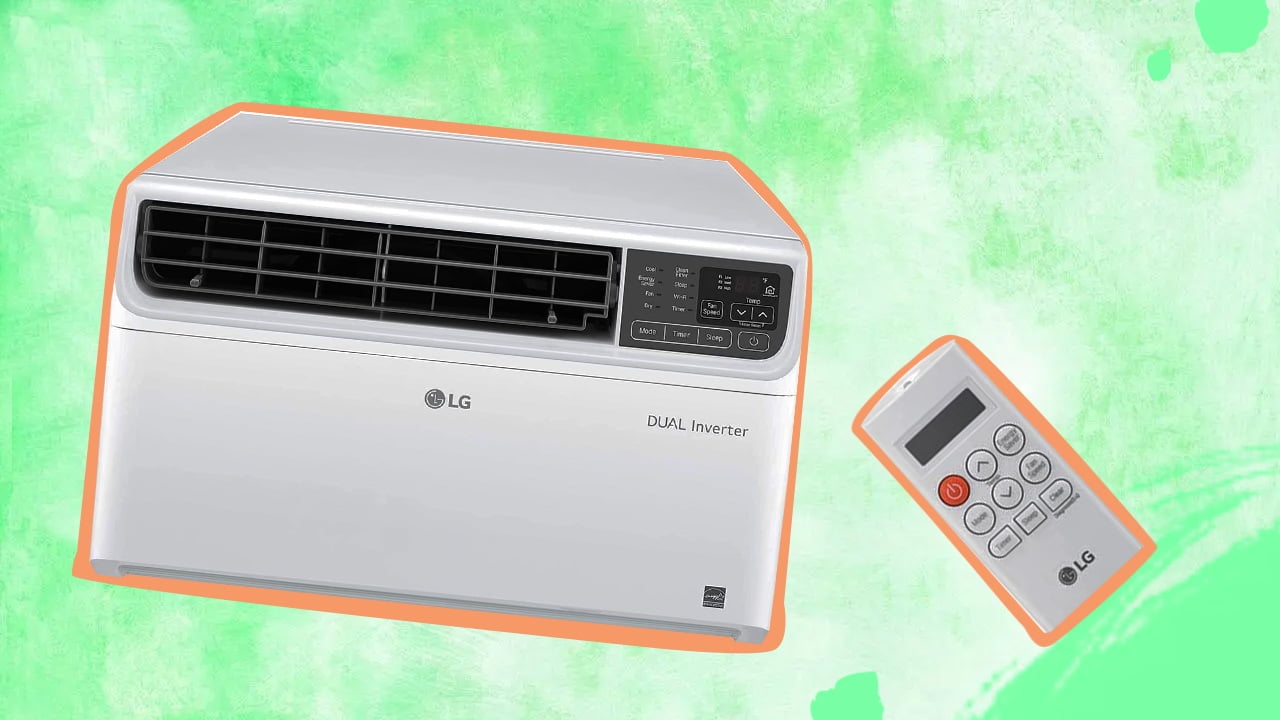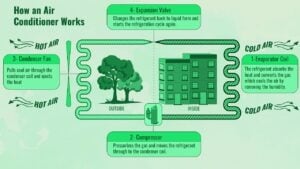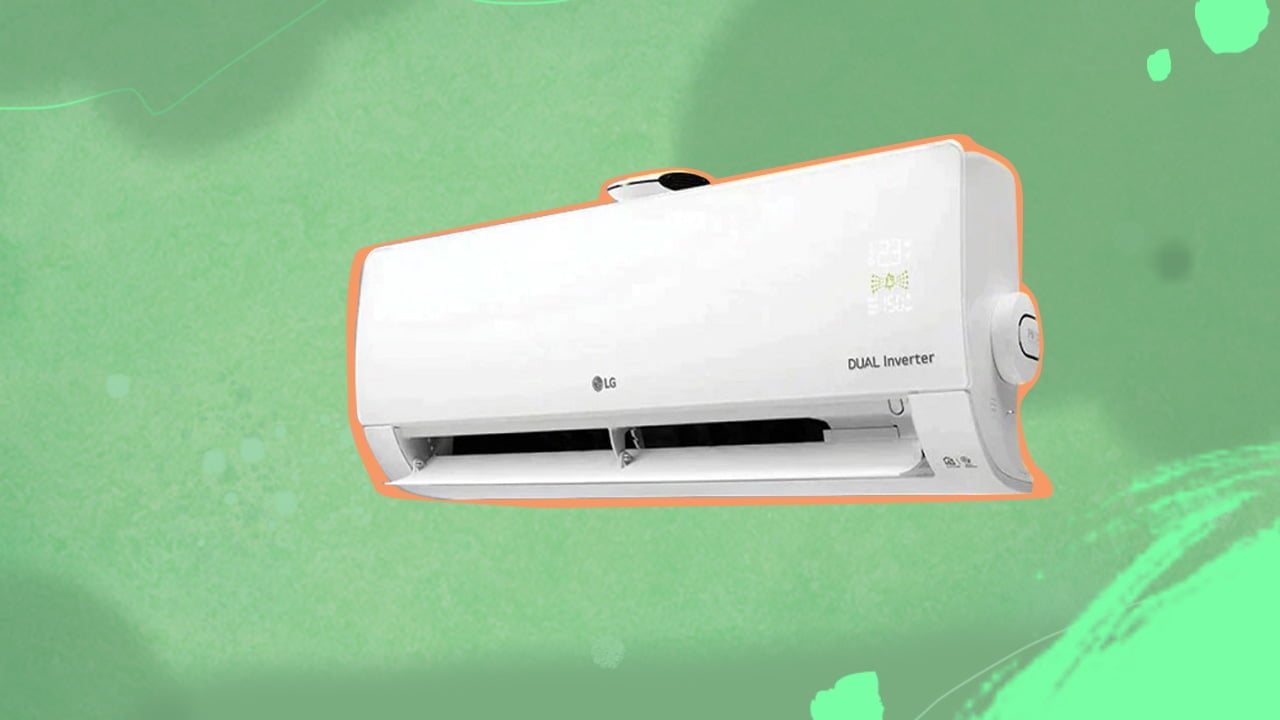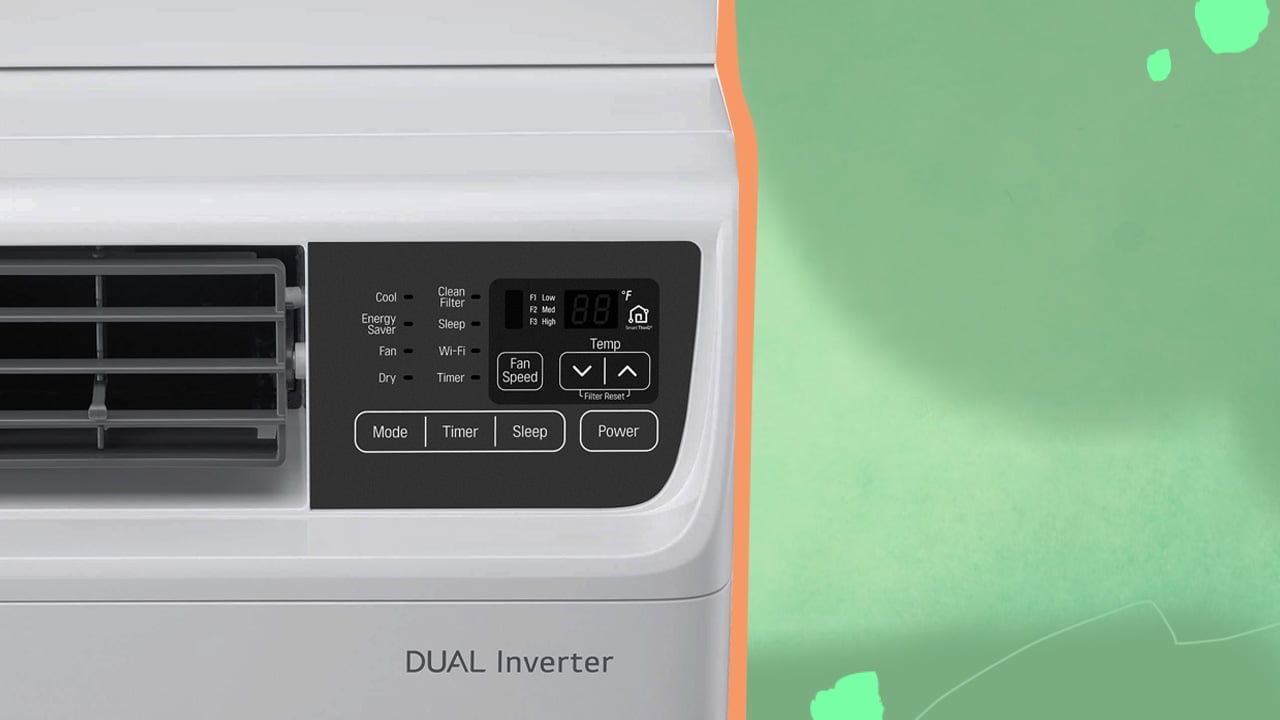Dual inverter air conditioners use two inverters that work in a complementary pattern, as opposed to traditional air conditioners, which use only one inverter. The twin inverters work in tandem to provide more speedy and consistent cooling on a lower electricity budget.

If you're in the market for a new air conditioner or just someone who keeps up with the latest tech, you must have heard the words "dual inverter system" get thrown around by brands advertising their latest models.
Therefore, you're curious about what this means and whether it's actually an improvement on the previous AC models. To help you understand that, I've detailed the regular functioning of an inverter AC and explained how dual inverter AC technology modifies it.
So, let's understand how a dual inverter AC unit functions in your home appliance and whether you should opt for it.
Components Of An Inverter Compressor

Before you understand the functioning of a dual inverter system, let's first understand how an inverter works using its various components.
Compressor
A compressor is a device that shrinks a gas's volume by squeezing it into a space smaller than its usual area.
Compressors are of several types, including scroll, piston, and rotary compressors. Of these, rotary compressors have the most efficient energy use, but they also make the loudest sound.
A rotation or scroll compressor is made of two spirals or scrolls woven into each other. Of these, one spiral is fixed to a support, while the other is free to rotate in any direction without being entangled from the first scroll.
Therefore, the rotating scroll can shrink or expand the space between the two scrolls, depending on its position. Gas in the space between the scrolls is compressed in this manner.
Shrinking a gas increases its pressure, and I'll explain how that helps when I elaborate more on an inverter's function.
Drive
A drive is also known by its technical term, Variable Frequency Drive (VFD.) It consists of an electric motor, interface, and controller.
The drive controller consists of an AC-DC or AC-AC converter that causes the periodic motions of the Brushless DC Electric Motor. Meanwhile, a programmable language controller acts as an interface and helps control the motor. Finally, the three-phase motor changes its speed according to the user's intention, which drives the rotation of the scroll compressor.
According to your AC’s specs, this drive can be powered by the direct current from your household electricity or a battery-powered AC with a rechargeable option.
Coolant
The refrigerant or coolant is a specific gas that needs to absorb the most amount of heat with the slightest compression. This makes the AC more efficient and reduces the space it needs to store the coolant.
Initially, the refrigerant used most widely in all inverter ACs was known as R-22. It was also called Freon and made of Hydrochlorofluorocarbon (HCFC). However, this gas emitted free ions into the atmosphere, and the ions broke Ozone apart into oxygen molecules. You must have heard about ozone depletion - this coolant was the primary reason for the hole in our ozone layer.
To combat this destruction, the Montreal Protocol urged companies to look for greener refrigerants, and an alternative was found. Most AC manufacturers today use R-410-A, which cools your room or basement efficiently without significantly impacting the ozone hole.
How Does An Inverter AC Work?

Now that you know about the power inverter AC components, I'll explain how the device works inside your air conditioner.
In an inverter AC, the single or twin rotary compressor periodically squeezes the coolant gas, which decreases its volume and lowers the temperature of the surroundings. Also, it passes over the condenser coils as it cools.
Have you noticed that water shrinks when you cool it and spills over the sides of the saucepan when you heat it? This happens because of thermodynamic laws. An inverter AC uses the opposite mechanism on a gas - It shrinks the gas, which makes it absorb heat from the air and become warm. Since the air around it loses heat, your room cools down.
Other than inverters, some ACs may use evaporative cooling to control the temperature of your room.
Dual Inverter Air Conditioner
Dual inverter air conditioners differ from ordinary air conditioners because they use twin rotary compressor chambers. Thus, they are faster and have more energy efficient than regular air conditioners.
These ACs were developed in light of the hotter summers. Because of global warming, more people need air conditioners now than ever before. However, inflation makes it difficult for them to keep up with the electricity bill increase that comes with installing a new AC and using it for longer durations.
These troubles are alleviated by the dual inverter AC system, which soothes you quickly on an exhausting afternoon while having maximum power efficiency.
Mechanism Of A Dual Inverter Air Conditioner
In a dual inverter AC, twin rotary compressors move periodically and have a 180-degree phase difference between their time periods.
A 180-degree phase difference basically means that the movement of the chambers is in the inverse phase. When one is at the peak of its motion, the other is at the lowest point. However, they meet in the middle.
Recall the functioning of the dual inverter compressors - the free spiral turns in an orbit while being weaved into the fixed spiral. Thus, the gas is squeezed to the highest pressure when the scrolls are closest to each other, and they're most relaxed when the spirals are far apart.
In dual inverter air conditioners, one compressor is at maximum pressure while the other is at its minimum. This means some refrigerant portion is constantly being used, leading to faster and more continuous air conditioning.
Dual inverter compressors have a specific frequency because the external drive moves them at a certain speed. When they change their speed, the amount of refrigerant being used also changes.
Thus, the time period of these compressors may vary anywhere from 720 to 90,000 revolutions per minute. This is the mechanism behind the AC changing its settings when you lower or raise the temperature. More refrigerant leads to more cooling and vice versa.
Thus, you can see how powering twin compressors can speed up your AC. When you want a lower temperature, the compressors will work in tandem and make the temperature change substantially faster.
Also, it has more energy efficiency because more cooling is achieved by using the same amount of energy to move two compressors instead of one. Thus, they use almost half the electricity single inverter systems of the same specifications would require.
How Do Dual Inverter Air Conditioners Produce Variable Tonnage?
First, let's learn about what tonnage refers to.
When purchasing an air conditioner, you must have noticed the tonnage rating. It determines the room size that a unit can cool because the tons, in this case, refer to the amount of electricity an AC needs to cool by a certain fraction per hour.
In mathematical terms, running a 1-ton air conditioner for an hour can cool a room by 12,000 BTU. In this context, BTU refers to British Thermal Units. Now, if we approximate that to the typical size and heat of people's homes, a 1-ton AC is suitable for a room smaller than 1000 square feet.
Thus, a higher tonnage means that the air conditioner drains more power and cools a larger space in the same duration as a lower-tonnage AC cools a small room.
This is why a dual inverter AC is a game-changer. Unlike regular inverter air conditioners, it doesn’t have a fixed tonnage per unit. Instead, it customizes the unit according to your room's needs.
Thus, if you buy an 8-ton dual inverter AC, it'll function at its full capacity of 8 tons during hot summer afternoons and use up more power. However, when you leave it on at night, your room will be cooler, and using more power would be a waste. In this case, your AC will function at 4 tons and cool the room adequately while saving electricity.

Benefits Of A Dual Inverter AC
You've probably seen advertisements praising the multiple benefits of switching to a dual inverter air conditioner. From the mechanisms and working principle above, you can deduce how it saves energy. However, if you're still doubtful about the other flashy advantages, I'll explain how they come to be.
1. Durable
Dual inverter air conditioners are durable because they can reach efficient cooling by doing much less work. Since two compressors move at once, they do it more easily than a solitary inverter would have.
Thus, your AC undergoes less wear and tear than a regular air conditioner. It means you can use it for years without noticing a decrease in performance or speed.
Also, these air conditioners need only a bit of maintenance. Since two compressors share the burden, there's a lesser chance of damage. Thus, you don't need to call your mechanic for frequent repairs or worry about whether your warranty covers the latest failure.
2. Quiet
Are you tired of the constant background hum of an AC every time you turn it on? Dual inverters can reduce this noise pollution in your home because they cool your room quickly and then turn off when they're not needed.
Thus, you'll only notice an occasional hum when your room heats up. Once it reaches the desired room temperature, you can go back to relaxing in the quiet.
Also, since the rotary compressors work in opposite directions, they create lesser jerky motions on the AC. This torque cancellation leads to minimize vibration and lower noise.
Therefore, dual inverter ACs are ideal for light sleepers. Additionally, they function great in office buildings or conference halls, where silence reduces distractions and enhances productivity.
Disadvantages Of A Dual Inverter AC
Like every new technology, dual inverter technology comes with some disadvantages. Thus, if you're considering a dual inverter air conditioner for your home or office, you can read through the points I've detailed below to judge if it's worth it for you.
1. Expensive
Since it's a recent and innovative development, its price is in a higher range than regular air conditioners.
However, the higher purchase costs also correspond to a higher value. You're getting an AC that has half the cost and electric energy consumption to provide almost double the cooling capacity. Therefore, it not only has better performance features but also saves you money every month.
However, the repair and maintenance cost for these inverters is also high. Since it's relatively new, you'll find fewer technicians skilled at working with it without using guesswork or unsafe methods. Thus, they'll charge more for their work because of the low availability and high demand.
2. Voltage Stabilizer Required
The electricity can fluctuate in numbers ranging from 150 to 300 volts for most people's homes. However, a dual inverter air conditioner needs a steady voltage to function without mechanical damage or loss of efficiency.
However, this may not always be the case. For example, some areas maintain a steady voltage of 250 volts at all times of the day. Thus, you can ask an electrician about the electricity fluctuation in your area and decide accordingly.
Despite this, installing a voltage regulator is always wise because you never know what will happen. Even if your house has been receiving a consistent voltage level, you might have a sudden fluctuation tomorrow because your power supply lines are being renovated or changed. Thus, a stabilizer will safeguard your AC and ensure stable operation.
Availability Of Dual Inverter Air Conditioners
Currently, the major brands distributing dual inverter air conditioners are LG, the Whirlpool Corporation, Hitachi, Midea, Freidrich, Senville, and a few others.
Additionally, the energy star ratings of the dual inverter ACs may vary, depending on the basic dual inverter compressor types used. For example, an LG dual inverter AC uses around 850 Watts, while a regular LG Corporation air conditioner uses around 5000 Watts when both cool the same room. Models with an inbuilt thermostat are also available.
Thus, if you buy a dual inverter AC, you should have a suitable choice of models from well-known brands. Also, both split and window air conditioners are currently available. The split dual inverter air conditioner was invented first, and the window or portable installation variety was more recently invented because customers had a need for it. Also, you can look for ventless varieties.
Should You Get A Regular Or Dual Inverter Air Conditioner?
Now, after learning the advantages and disadvantages of a dual inverter air conditioner, you might be wondering whether you should buy one. Below, I've jotted down a quick comparison to help you choose the product that's right for you.
- Dual inverter ACs tend to have higher upfront charges than regular ACs.
- Regular air conditioners generate much higher energy costs than dual inverter units.
- A dual inverter AC has higher repair costs.
- Regular AC inverters break down more frequently than dual inverter units, resulting in frequent repairs.
- A dual inverter AC lasts longer on the same refrigerant amount.
- A regular AC produces noise at around 60-80 decibels, while a dual inverter air conditioner stays within 50-55 decibels.
- You'll find a regular AC very easily, but you need to do more searching and comparing prices to find a suitable dual inverter AC.
Tip
If you're considering a new AC model but are unsure about whether it is a dual inverter AC, there's a quick way to find out. This relatively new technology will make people's lives a lot easier, which is why any brand that sells it is eager to advertise it. Thus, if you're viewing a product catalog or description, you'll find "Dual Inverter" or "Dual inverter AC" displayed quite prominently at the beginning.
Of course, you should always read the rest of the information thoroughly to know whether the product is right for you. But if you're looking for a dual inverter AC specifically, the first part of the product description is usually a dead giveaway. If you don't find it at a glance, chances are that this model is a single-inverter, and you should consider a different option.

Summing Up
Now, we're at the end of my brief guide to inverter technology and how the dual inverter AC is an improvement upon previous models. If you're eager to invest in higher upfront and repair costs to save a ton of electricity in the long run, you should look into these ACs.
A dual inverter AC unit comes with its benefits and drawbacks, and you can read my explanations to figure out if you want one. A general rule of thumb is to write down what's important to you and choose according to these guidelines.
For example, if you just want a small AC that cools your tiny dorm to your desired temperature, you're probably not too bothered about the electricity bill and looking for a cheaper option. On the other hand, you might live with your family and have a transferable job that leads to you changing your bedroom sizes over the years.
As a result, I would advise you to avoid a dual inverter AC in the first situation and go for it in the second. So, know your needs and make the best choice.
